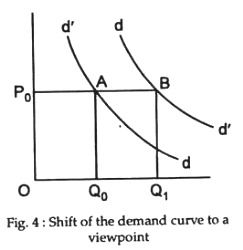This article will help you to learn about the difference between shift in demand curve and movement along the demand curve.
Difference between Shift in Demand Curve and Movement along the Demand Curve
Demand is the whole list of quantities that will be bought at various possible prices. Any movement of prices will lead to a different quantity demanded, but it represents the same demand. In terms of downward sloping demand curve it means moving up or down the original demand curve, dd as in Fig. 3.
Other things being equal, there is a unique schedule of supply or demand in any period of time. But, other things do not always remain unchanged.
The demand for oil is rising over the years because of growth in population and car ownership. As tastes changes, incomes vary, as the prices of substitute products (coffee in relation to tea) or of complementary goods (sugar in relation to tea) change, the demand schedule will shift.
ADVERTISEMENTS:
So, in reality we must distinguish between an increase in demand — by which is meant a shift of the whole curve to the right and upward, as more is now bought at each (same) price — with an increase in the quantity demanded as a result of moving to a lower price on the same demand curve.
Here are some factors that might lead to an increase in demand in our example: a hotter day, a larger group of people, people with more money, effective advertising on the trail by the stand owner, greater desire built up by soft drink makers through advertising.
Increases in demand (and, conversely, decreases, too) can be traced to three things:
ADVERTISEMENTS:
1. More population
2. More income in buyers’ hands
3. More desire for the particular good
The effect of an increase in demand is to raise the quantity demanded of any given price. On the graph in Fig. 4 the original demand for soft drinks is shown by demand curve DD. But, the demand curve DD is a curve that reflects an increase in demand.
ADVERTISEMENTS:
So, by demand we mean the whole demand curve; by an ‘increase in demand’ is meant a shift of the whole curve in question to a new position (in this case to the right). To indicate a single point on a demand curve, we speak of the ‘quantity bought’ or ‘the quantity demanded’ at a particular price (Fig. 4). A movement along the same curve is ‘a change in the quantity demanded as a result of a price change’. It does not represent any change in the demand schedule.

